
Featured Topic: Using Games to Help Students Acquire Basic Facts Mastery
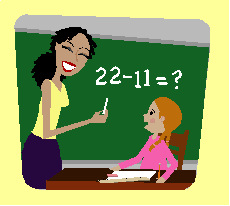
|
What we learn with pleasure, we never forget. For years, teachers have used worksheets to provide practice in basic facts. This practice has not produced the desired outcome for many students so consider a different approach. Use games regularly in the classroom to provide targeted basic facts practice and to differentiate practice to best meet the varied needs of students in the classroom. Students enjoy these math games and forget they are "doing math." Students who have fact power are the most successful in winning these games, so there's a natural motivation to learn the facts and increase the odds of winning.
|
Recent Additions to Mathwire.com
Added on August 9, 2009: Contig Jr. Game
Contig is a very effective game that encourages students to master basic facts (+ - x /) in order to get the most points with each play. Contig Jr. is designed to provide that same format for younger students who need to develop mastery of addition and subtraction facts.
- Download the directions and game board for
 Contig
Contig
- Download the directions and game board for
 Contig Jr.
Contig Jr.
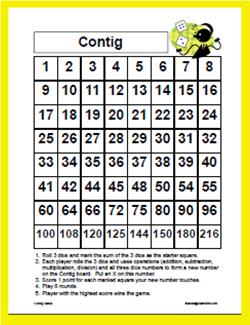
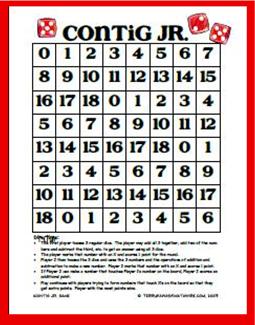
|
How to play Contig Jr.: Player 1 tosses 3 dice. He/she then uses those 3 numbers and the operations of addition and subtraction to make an answer that is on the game board. For example, if the player threw 3, 5 and 2, the player could form these numbers.
The player may mark an X on any one of these numbers (10, 6, 0 or 4) anywhere on the board. He/she gets a point for being able to make an X on the game board. If his/her X touches other X's around it, the player gets an additional point for each X it touches (even at corners). Players learn to select the number that touches the most other X's to get the most points. With more experience, players learn to try out all of the different possible combinations, as listed above, in search of the number that will give them the most points. When players reach this stage, it is optimal play for the development of "fact power" as they mentally rehearse lots of different combinations in search of the perfect move. |
Added on August 7, 2009: M&M Probability Game Pieces
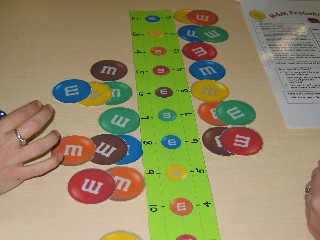
In the In response to several requests, Terry Kawas has created |

M&M Probability Game Pieces |
Added on August 5, 2009: Online Resources for Writing in Math Class

|
|
Added on August 4, 2009: Three Strikes and You're Out! Game
|
Students need lots of practice to learn and master basic facts. Games are a fun way to provide regular practice and they can be easily differentiated to accommodate the varied needs of students in a class. The Three Strikes And You're Out! game is designed to practice addition or subtraction facts. The game uses the sum of two dice to practice addition facts, but may easily be adapted to practice subtraction facts by using two 12-sided dice and finding the difference. The game handouts include directions, variations in play and scoring, game boards for both the addition and subtraction games, as well as game pieces that may be used to support the baseball theme.
Similar Games to Practice Addition and Subtraction Facts:
|
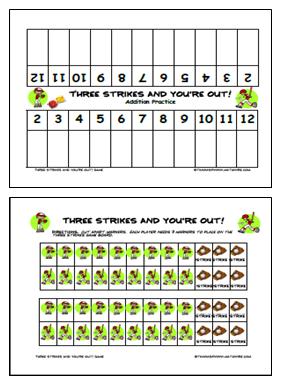
|

Mathwire Archives:

See  Mathwire Archives for past issues of What's New on Mathwire.com and for past month's featured articles.
Mathwire Archives for past issues of What's New on Mathwire.com and for past month's featured articles.

